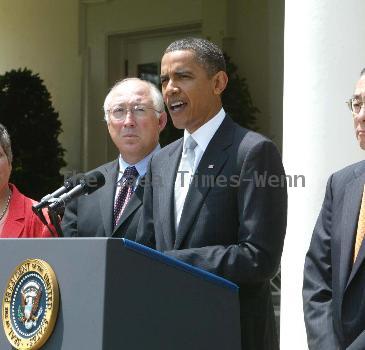FDA takes its time on tobacco regulation a year after new law; aggressive moves still far off
By Michael Felberbaum, APTuesday, June 22, 2010
FDA takes its time on tobacco regulation
RICHMOND, Va. — A year after a new law put tobacco regulation in the hands of the Food and Drug Administration, one thing is clear: It will likely be years before any of the most aggressive steps to reduce deaths from smoking might happen.
When President Barack Obama signed the bill into law last June, anti-tobacco advocates suggested it could lead to a reduction in nicotine levels, a ban on menthol cigarettes or other aggressive moves.
Such moves are still a long way down the road as the FDA takes its time assessing the scientific evidence for what would best improve public health. That leaves the future of the industry and effects on both companies and consumers under a cloud of smoke.
But for public health experts, one thing is clear — more needs to be done to snuff out the death and disease caused by cigarettes and other tobacco products, and stop people from using them in the first place.
The FDA’s measured approach hasn’t stopped it from making changes prescribed by the law: limiting marketing, especially to children; banning flavored cigarettes except for menthol; removing labels such as “light,” ”mild” and “low-tar” from cigarette packs; and increased the size of warning labels on smokeless tobacco. It has also begun to look at the ingredients in cigarettes as well as the health impacts of menthol and dissolvable tobacco products.
In a short period, the FDA has made real progress that will begin to have a meaningful health impact, said Matthew Myers, president of the Campaign for Tobacco-Free Kids.
While the law doesn’t let the FDA ban nicotine or tobacco outright, the agency could lower nicotine to non-addictive levels. And that’s exactly what former FDA Commissioner David Kessler, who championed the anti-tobacco public health movement, wants to see happen.
“The tobacco industry knew 40 years ago that there was a threshold below which people would quit,” Kessler said in an interview with The Associated Press. “Reducing the level of nicotine in cigarettes will change cigarette smoking as we know it. It is the ultimate harm reduction strategy.”
Most smokers ingest between 1 to 3 milligrams of nicotine per cigarette. Kessler suggests that the FDA lower that number to between 1 and .5 milligrams.
While some will argue such a proposal is akin to prohibition, making cigarettes less addictive would reduce the vast majority of the more than 400,000 deaths per year from smoking in the U.S., Kessler said.
“It is now time to reverse the trajectory of smoking initiation, sustained addiction and premature death,” he said. “Ultimately the agency’s success needs to be measured in terms of the number of people who smoke and the number of kids who start.”
Kessler’s suggestion to make tobacco less addictive deserves “serious consideration,” said the Campaign for Tobacco-Free Kids’ Myers.
There are two approaches to regulating tobacco use: one that says there’s no safe way to use tobacco and pushes for people to quit above all else. Others embrace the idea that lower-risk alternatives like smokeless tobacco and other nicotine delivery systems like gum or even electronic cigarettes can help improve overall health.
The law lays out the possibility for both, prescribing a scientific approach to improve public health, said Dr. Lawrence Deyton, director of the FDA’s Center for Tobacco Products.
“There’s multiple strategies the FDA will be considering,” Deyton said in an interview with The Associated Press. “We certainly have not made any determination on one side or another.”
Deyton did not say whether Kessler’s suggestion would become a reality, but said the law does allow the FDA to set nicotine levels.
No matter the approach, Deyton said he wants Americans to trust what the agency’s work on tobacco.
“We now get the opportunity to speak the truth about tobacco products and do so in a reasonable way,” Deyton said. “We will not do it as zealots, we will not do it as aggressive government. We will do it in a methodical, reasonable way.”
Within the next year, a scientific panel will issue recommendations on how the FDA should regulate menthol-flavored cigarettes. Smokes with the minty flavoring are a key area for growth in a shrinking cigarette market. Most industry observers think a menthol ban is unlikely.
The FDA also must issue guidelines requiring larger, graphic warning labels for cigarette advertisements and packages by next June. Tobacco companies will have 15 months to comply.
A suit filed by several tobacco makers claiming the marketing restrictions, including a ban on color and graphics in most tobacco advertising, violate their free speech rights remains in federal appeals court. A federal judge in Kentucky upheld most of the restrictions, but both the FDA and the tobacco companies that challenged them have appealed parts of the ruling.
Tags: Barack Obama, Government Regulations, Industry Regulation, North America, Public Health, Richmond, Smoking, United States, Virginia



